Deborah Wiles's Blog, page 7
April 2, 2025
Writers Lab: The Peace Builders Pledge
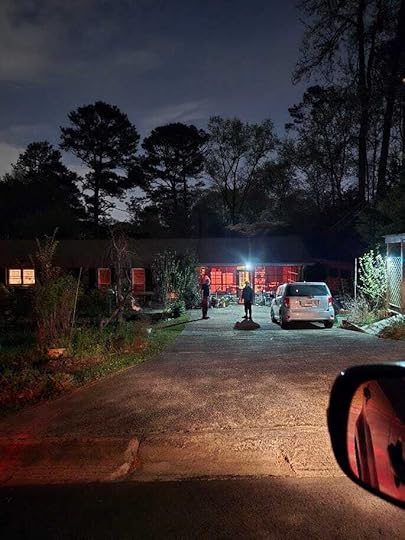 pretty peaceful
pretty peacefulI snapped this photo from inside my car at 6am on Sunday as the guys waved me off on a road trip to the Washington, DC area where I’ve been all week, working in Title 1 schools with students in grades K through 5 and their teachers, writing and reading and telling stories together.
We have encountered the folly of “best laid plans” every day, even though the planning was meticulous. The wrong sound system, the wonky microphone, the screen that won’t talk to the laptop, the screen that isn’t big enough for everyone to see, the messages that go missing so that kids bring notebooks to a multi-grade assembly and 400 kids with notebooks and clacking pencils in one fell-swoop is too many kids and notebooks for a writing workshop, especially when one group that troops into that assembly is from pre-school.
hahahahaha. I’m laughing, because we got to laughing about all this at dinner the first night, and nearly fell off our chairs recounting all the snafus — how were we still standing? And how did we manage to pull it off anyway? (hint: excellent punting skills and lots of experience.)
On the first day alone, one child in the back of an assembly vomited, and one near the front missed his bathroom opportunity. The intrepid organizers and an occasional (also excellent) techie performed a Katzenjammer Kids routine in the middle of an aisle in a room full of cafeteria tables and kids and notebooks.
They finagled the sound — switching out (and moving! they were heavy!) speakers and cords and mics and what-nots, from the back of the room to the front, in some insane-looking frenetic ballet, mid-room, trailing cords everywhere, while the author (that would be me) kept going, walking past the fixers, back and forth, talking all the way, and taking a new mic handed to her every few minutes, like it was “nothing to see here!” and asking the assemblage, “Is this better?” and just kept going. I mean, we were on a tight schedule, and there were 400 kids in that room. omg, I’m laughing again just picturing it.
Someone very helpful (really) with the faltering sound in an assembly the next day had to finagle the settings on the laptop so two screens would talk to each other (and not the laptop screen) which inadvertently shifted the PowerPoint slides for Freedom Summer, the book I always end with for grades 3 through 5. I could see the slides weren’t corresponding with my memorized reading, so I stopped clicking through and kept right on “reading” the book while I calmly walked to the computer and fixed the slides.
The usual, right? It really is. When you’ve got this many schools and this many students and teachers and staff, this much movement and a marshalled schedule, it goes beyond “it takes a village.” It’s a beaches-of-Normandy type planning event. Once things settle, and they do, lots of learning takes place (for alll of us, lol). And it has been a fabulous week. Fabulous teachers, fabulous students, fabulous administrative staff (and this week has seen me fall in love with principals again, go figure), and fabulous work we’ve done together.
As I said in a Note, it has been a week of surprises, and none more so than the “unicorn” Title 1 school (the principal’s word for her school) of amazement I encountered this afternoon. I end workshops and assemblies by citing my mantra that every human being is worthy of dignity and respect, and every person’s story is important, that it’s hard to hate someone when you know their story.
I tell young writers that we ARE stories, and that it’s so important to listen to others tell their stories, and to tell/write/draw/dance/sing our stories, too, because that is the way we create peace… peace… on… earth, I say, with great sincerity and finality and assurance that I know something.
When I told the assembled K-2s, at the end of our time together today, that telling our stories is the way we create peace, the principal added, “We say a Peace Pledge every morning after the Pledge of Allegiance.” I said, “Really? I’d love to hear it.”
And, I kid you not, as if I’d asked them to (and I guess I did!), every child dutifully stood up, en masse, like an event that had been rehearsed. They each held up two fingers on one hand with the universal sign for piece, and began the pledge along with the principal and every teacher. All those young faces! All those sincere words, spoken so strongly, steadily, in unison and solidarity. All that hope for the future:
 This is the Peace Builders Pledge posted on the wall at Claude Thompson Elementary School in Warrenton, Virginia.
This is the Peace Builders Pledge posted on the wall at Claude Thompson Elementary School in Warrenton, Virginia.The Peace Builders Pledge is not unique to this school, but they did tweak it to reflect their school in particular. I teared up with surprise at being so “in country” in such a call-and-response way. I was also exhausted, but that’s another story. :> Here I have talked so often, and for so many years, about creating peace, and I find myself smack-dab in the middle of the Peace Builders.
Which brings me to this week’s Lab Assignment, and a funny story about Claude Thompson Elementary’s Peace Pledge that goes with the recitation of the Pledge of Allegiance. Don your Lab Coats, your Dusters, your aprons, your Chore Coats, your fuzzy blankets, whatever suits you. Sharpen your pencils, turn to a fresh page in your notebook, good luck, and happy writing!
If you’d like to join us in the Lab, here’s your button to do that:
Your Lab Coat Awaits! Join the Lab
THE ASSIGNMENT:
March 31, 2025
Storybelly Digest #7: Going Away
Good Monday morning! Hello from six elementary schools in the Washington, DC area this week, students in grades K through 5, their teachers, and a family literacy evening, all in all a good week’s work, plus, an old friend to reconnect with, new friends to meet, some excellent family sprinkles included, so many new stories told. This is the path to peace, I tell you: Stories.
Dance them, sing them, paint them, draw them, tell them, write them. “Story is the primary vehicle human beings use to structure knowledge and experience.” — Richard Rhodes. Amen.

So, some peace, through some stories, for a home-centric Digest. My “edible yard & garden project” has stories to tell. Here is how I’m leaving it:
Since I took the above photos — just Friday! — the yellow pine pollen has erupted in earnest here, and everything is coated with it. See the tiny Celeste fig below in the middle top photo… the fig leaves are covered in a fine coating of pollen. Same with the Tallulah Sunrise azalea, bottom left, and the wildlife pond that needs cleaning out for spring and refreshing. The only thing below not covered in pine pollen is Bobo Milo Cosmo Cannonball Frank Johnson. :>
That’s a loblolly pine, top left. It volunteered in my peach guild 2 seasons ago and I’ve left it there. It’s about 4 feet tall now. The 100-footers will be dumping their pollen all over us for the next three or four weeks. The deer seem to leave this baby loblolly alone, while they’ve all but destroyed a tender red maple I didn’t put a protective chicken wire sleeve around this winter. Sigh. The deer love the figs, too, and the young apple trees. My ops-guru saw three deer traipse through the back yard this past week, in the middle of an afternoon. Our native habitat seems to be a buffet for them.
Our small space on the planet needs springtime attention, and I’m always delighted to turn from inside chores to outside chores, especially after this cold winter in Atlanta. Turning on the outside water went… gushingly… this week. Now that overnight freezes are (I hope) over until next winter, I’m making plans to retool an outdoor shower in this spot. When we first built it, grandgirl A was so small and full of wonder, she wanted a summertime shower twice a day — in her bathing suit — and helped me set up all the accoutrements and enhancements, singing through the whole experience.
It’s mating and migration season, so we’re feeding the birds (we have two bluebird families this year! And there’s my bird wrangler, below) and making hearty meals to fuel ourselves for the outside work. I downloaded Merlin a few weeks ago and we’re learning the calls and particular shapes and colors and habits of the many backyard birds that come to the feeders, hide in the native thickets, and bathe at the water stations where we can watch them from the kitchen windows.
Yesterday, near the end of the day, after some pond cleaning, I was serenaded by barred owls — who-cooks-for-you? — over and over. These owls have been friends here for years. Same with the hawks. While sitting in Irene (our screened porch) and going through seeds yesterday, we saw a hawk swoop into the yard, scoop up something tiny, and fly off through our “lean-to” overhang where the firewood is piled high, and on into the sky. It was one looping, diving, soaring, smooth motion. You could hear his wings beat the spring air as he swooped down and back up again.
We’ve scarfed curry and beef stew and glasses of milk, we’ve enjoyed the explosion of redbud trees and the gift of beremeal bread from a friend, and there’s Julia Child whispering in my ear, “You can never have too much butter!” (Or mayonnaise, I suppose — remember our friend Flannery O’Connor and how much she loved mayonnaise — she would love those roast beef sandwiches the next day, on sourdough bread no less.)
I should stop. I’m writing this on Saturday afternoon and I leave early Sunday morning. I have packing to do, and PowerPoint slides to organize, and equipment to check out and make sure its working, and shoes to find. It will be hard to leave this place. It is always hard to go away. So much happens, every day!
I don’t really leave this place, though, right? I’ve been talking for weeks now about how we take our ancestors with us when we write, when we travel, and maybe we take it ALL with us, eh? That’s my altar in the Bingo free space above, and my work below that, and my life, in all these photographs, all these moments, memories, and meanings I make of them.
For years after I moved from the DC area to Atlanta, I mourned the loss of my home, the house I had lived in for fully half my life at that time — 25 years — and the house where I had raised a family, had become a writer, and then an author, had learned how to cook and garden and be right-sized, and so many things, and had done a lot of growing up, myself.
I had lived in the DC area — Camp Springs as a kid (which I write about in Countdown), Merrifield, Falls Church, Arlington, Alexandria, Gaithersburg, Frederick — for so long and had worked in Washington, DC itself, as well as Bethesda and Rockville, in office jobs, in trailers on construction sites (building the DC Red Line of the Metro!), taking in the city with my kids, in the salad days when the Smithsonian museums were open after work and we’d pack a picnic and go to the mall to hear the Air Force band play then mosey to the Natural History museum as the sun fell, to see the blue whale once again.
Moments, memories, meaning. I was so homesick. For so long. Now I have lived in Atlanta for 21 years and leaving the home I’ve built here makes me homesick. How do you say you’re a homebody without saying you’re a homebody. You write a thousand words about it. lol.
I do believe in the cumulative roll and weave of everything (all the messy glory, as Uncle Edisto tells us) in your past creating your present and inviting you into your future. I’m counting on bringing back the moments, memories, and meanings from every day on the road this week, to add to this life of mine while I’m out there doing this:
Once I’m in it, all else will fade, and I will delight in concentrating on the task at hand. I want every young (and not-so-young) reader and writer to know that they make a difference by telling their stories, writing them down, sharing them in whatever way sharing them works best for them. This is something each of us can do for ourselves, for those we love, for those we don’t know, and for the world.
I say it all the time: it’s hard to hate someone when you know their story. What you know, what you feel, what you can imagine: We take our lives and we turn them into stories.
It’s all I have done with every book I’ve written. “All.” I know. It’s a process You can do it. We all do it. I’m focusing on We Are All Under One Wide Sky this week, for youngest readers and writers, and on Love, Ruby Lavender for grades 3-5. These books are certainly fiction. But they come right out of my moments, memories, and meaning from my childhood, and — and! — from what I have learned along the way about the importance of paying attention, asking questions, and making connections.
That’s why Storybelly exists. I wanted a place to do these things in community, with you. Thank you for coming along with me.

No Storybelly Extra this week, but there will be a post for the Writers Lab (I’m going to write “Writers” without any apostrophe; it has been decided). We’ve been investigating Food, Firsts, and Ancestors, and we added a twist in the assignment last Wednesday.
On April 9, our “spring semester” begins. If you’d like to join us, it’s easy to do… we’re a very warm-hearted and enthusiastic bunch who want to cheer you on as you work with your own stories, be they fiction or memoir or non-fiction, essay, however you heart leads you. We’re here. One Lab Coat even went out and bought a SIFTER this week, after last week’s Digest about The Art of Sifting. Ha! I am so proud. :> We are nothing if not intrepid. Come be intrepid with us.

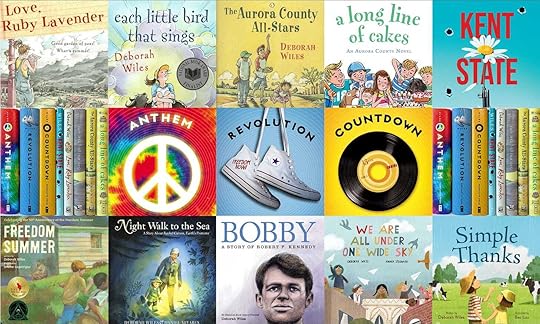
Life Story, in several volumes. :>
I’m proud of the publishing partners who helped give birth to these books, to the teams that have helped them find readers, and I am grateful for every reader who opens these books and sees a bit of history and home, community and compassion. I hope readers connect to their own place in history and home when they read my books. You can find out more about each book, and you can buy them, too, at my website. You can also check them out at your local library, and on Libby.

I have had an “Alligators All Around” earworm going for days. Don’t click on the link if you don’t want one, too. :>
The Assignment: Write your own alphabet book right now — don’t think too much about it, just start. (We Are All Under One Wide Sky is a counting book, one through ten and back again, morning, noon, to night… I will tell you about it sometime, but in the meantime, try an alphabet book like this one, thank you Maurice Sendak and Carole King, or a counting book, or something about the seasons… there is something very freeing about writing to a form.)
See you on the other side of this trip! Have a good week. Tell your story!
xoxo Debbie
March 26, 2025
Writers Lab: Paris, Flannery O'Connor, Marjorie Kinnan Rawlings: Write Your Story
Isn’t it just like me, when getting ready to travel for work, to begin planning a trip for fun? I do it every time. I leave Saturday for the DC area, to work in six (count ‘em) Title 1 schools, grades K-2 in the morning, grades 3-5 in the afternoon. They’ve asked me to work with We Are All Under One Wide Sky for K-2 and with Love, Ruby Lavender for grades 3-5, and I will be happy to do that, plus facilitate a family literacy evening on my last day there.
Putting together a trip like this, when I’m driving so I can go through Charlottesville for research on my way home, has so many moving parts. I will be very glad to do this work once I’m “in it” — it’s very good work, showing how life turns into story and encouraging young readers and writers — and families — to tell and write their stories. I get bogged down in planning details at some point and begin day-dreaming of a trip that’s “just for fun,” but who am I kidding? I can plan it all I want, but a trip is always for working, on some level, maybe because I have gotten into the habit of looking at everything through the lens of curiosity, and potentially as a story.
Jim and I went to Paris in October 2023, a trip that was delayed by 50 years (50!), which is a story for another time, but while there, in the Paris of my long-held dreams, I was writing a memoir in my head the entire time. We went to the Sorbonne, where I had been planning, so long ago, and for most of the years of my young life, to be a student in my junior year of college and to live in Paris. I sat on a bench in a tiny park across from the imposing “Sorbonne Building.” (In the 1970s, exchange students at the Sorbonne in Paris would have attended classes in the historical Sorbonne building, which housed multiple universities and institutions.)
I had an excellent view of the building and the huge front doors I would have entered as a junior in my exchange-student year. I began to tell Jim about those years, and I realized, I was suddenly saying my hello and my goodbye to that dream, while sitting there facing it, in that city I’d dreamed about for so long, the city of my future that was here, finally.
Then the most unexpected thing happened: I became teary-eyed with actual happiness, because I was also affirming my life as it had turned out.
It’s a good life. I am grateful for all of it, the many decades I’ve been lucky enough to live this life, the pain and the joy alike, and everything in between. Maybe this is a gift that time and maturity and growth and whatever-it-is can confer. Maybe it’s perspective. Maybe it’s that I’ve found everything I ever hoped for in my life, really. Like Dorothy says in the Wizard of Oz, I had it all along, and I knew it. I’m happy, I’m blessed, all the things we say, and I mean them. I have led a charmed life.
I will say, though, that when I saw the Eiffel Tower for the first time in my life, I wept. And I want to write that memoir.
I fail (and fall) into this other-planning when I’m writing, too — do you? I’ve got this deadline for Charlottesville, and what am I doing? I’m dreaming about Ray Bradbury, and Cambria, and Hi, Evelyn!, and We Built A Pond, and even very old, unsold work, a full novel called Hang the Moon (a title I chose in 1995, that someone has used as the title for their book recently, I saw somewhere….), let me write anything but the work-at-hand. The contracted work at hand, I might add.
So let me get to the Substack work-at-hand and stop using Google Maps to chart a trip from my home in Atlanta to Andalusia, Flannery O’Connor’s homeplace in Milledgeville, Georgia, then on to Cross Creek in Florida, to Marjorie Kinnan Rawlings’ home, both places that have been on my list to visit ever since I moved to ATL twenty years ago, almost twenty-one.
But doing that planning and daydreaming brings me to Flannery O’Connor’s birthday, which was yesterday — her 100th birthday no less! I find O’Connor’s novels and short stories hard to read, possibly because I am a wimp at heart and find horror and gothic stories hard for me to process and O’Connor — like Shirley Jackson who is equally hard for me to read (I consider this a personal failure, as I love both writers) — is so raw and honest in her work.
But, I will say, I adore Flannery O’Connor’s letters.
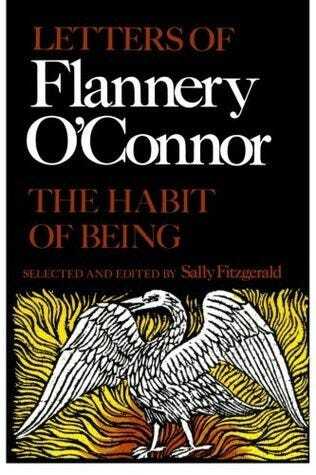
Her letters are collected in a book called The Habit of Being, which I used to own, but gave away over 20 years ago to a woman in Maryland who cut my hair for years, and was beside herself one day because her young-adult daughter had just been diagnosed with lupus. Flannery O’Connor had lupus, and writes, in her letters, about the disease and her increasing frailty. I don’t know what possible help that book of letters could have been to my hair-cutting friend, but I wanted to do something, and so I impulsively pressed the book into her hands one day and wished her all the luck, before I moved to Atlanta.
I haven’t read those letters since, but someone else has, and that’s where we start with the Writer’s Lab today, with this piece written by Caroline McCoy and published at LitHub online in 2019, titled “Flannery O’Connor’s Two Deepest Loves were Mayonnaise and Her Mother.” There is a subtitle, too: “A Southern Gothic Writer, A Very White Condiment.”
The first sentence got me to thinking about how we depict Mothers in our writing:
“In her short lifetime, Flannery O’Connor wrote more than 600 letters to her mother.”
I came for the Mother-talk, I stayed for the Mayo, and I did that because of last week’s Lab assignment to write about a First, a Food, and an Ancient one.
We shared some of our stories in the Chat last week, and I hope we’ll do more of that this week, as the assignment is designed to get you thinking about your own story within a framework, while writing short, and including elements that might not seem to go together, but wait!
Just as we get a kind of freedom in writing poetry to a designated form (as opposed to free verse), we are given a different way to think about our personal narrative when we take “one from column A, one from column B, one from column C” and see what they suggest.
This sort of exercise is what broke open Ruby Lavender for me, and helped me to move it from being a poem about my own childhood, to a novel with fictional characters and situations, but all coming straight out of my life.
The importance of mayonnaise in Flannery O’Connor’s life slays me! Here are a few key lines from this well-written, insightful piece by Caroline McCoy:
Of all the edibles that appear in the author’s correspondence with her mother, one inspires her most enthusiastic commentary: mayonnaise. She loves the thick, eggy spread…
She considered the condiment a staple…
The canned pineapple she chilled on her windowsill seemed lackluster without the familiar white dollop. Her tomatoes were all but naked. Where her sausages were concerned, mustard was a poor companion. She requested that her mother send her the homemade mayonnaise of her childhood…
The entire essay is good writing — and there is a bonus element in this piece I want you to notice… what’s working? We’ll talk about that in the Lab Chat this week, along with what’s working in our own writing as well.
Join the Lab and Make a Mess with Us!
So Flannery O’Connor’s letters are full of food. Marjorie Kinnan Rawlings lived on a 72-acre orange grove in Cross Creek hamlet, and told an interviewer from the Christian Science Monitor in 1940 that her only vanity was cooking: “I get as much satisfaction from preparing a perfect dinner for a few good friends as from turning out a perfect paragraph in my writing." Her memoir, Cross Creek, is full of the food she prepared for guests and gatherings. Her novel The Yearling describes the fried green tomatoes and fried catfish, vegetables from the garden, venison, and grits she encounters with her neighbors and how she grows to love them (the neighbors and the food).
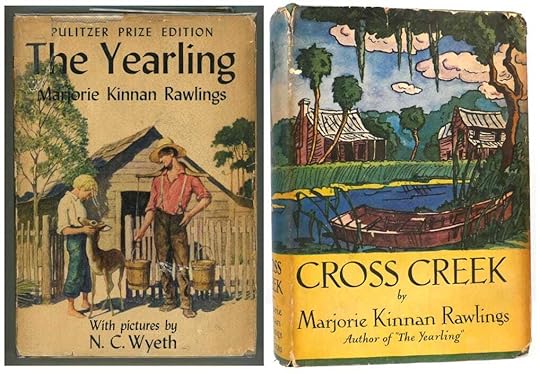
You might imagine I’m going to ask you to write about Marjorie and oranges or Flannery and mayonnaise this week, but (alas?) no.
The assignment for this week builds on what we started last week, and has whiffs of what you’ve just read. And here it is, below. You’ll find a bit of Sissy Spacek below, too, to help you think about your writing this week.
Happy writing! Make a mess. Experiment! And share with us in the Chat!
THE ASSIGNMENT:
March 25, 2025
Storybelly Extra: Alligators All Around
I can still hear Carole King singing “Alligators All Around” from the album “Really Rosie,” still see Maurice Sendak’s art when I close my eyes, still see my Ops-Guru (who was an 8-year-old then) oh-so-carefully placing the needle onto the record on his Fisher Price record player, to sing along with “Chicken Soup With Rice” one more time. There’s a food for ya. (All song links are at YouTube.)
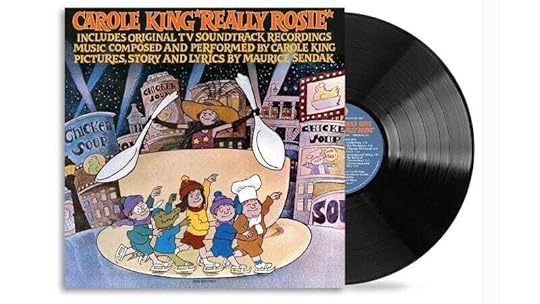
This year marks the 50th anniversary of the Really Rosie album… does that make it an ancient one, an antique? I met Sendak at a reception when I was teaching in the MFA program at Lesley University in Cambridge, Mass. Candlewick had brought him over for an evening talk and reception with all students in the program. I had neatly tucked my children’s love-tattered Nutshell Library books into my suitcase for the residency, even though I would never have asked Mr. Sendak to sign them. Maybe I brought them for good luck.
He stood in the middle of a sea of students from every MFA discipline — art, music, fiction, poetry, non-fiction and writing for young readers — for he wrote and illustrated brilliantly in, and was revered across, all genres. I watched his “game face” fade a little as he shook hand after hand, and listened politely to every person who wanted to tell him of their admiration of his life’s work. All those bright, expectant faces looking on and looking him square in the eye! I was one of them.
We were a small group, in that first year of Lesley’s shiny new MFA program, so we had quality time with Mr. Sendak. After I mumbled something-or-other and he was gracious back, I watched him move, chat, refuse something to eat or drink, grump a little (I would have been disappointed had he not :>), tender his scarf around his neck and say he was ready to go. We parted, like the Red Sea, to allow him to do so.
He had not been well, and we were glad he could come. We knew we had experienced a rare moment from an artist who made few public appearances at age 76, and I wondered as I watched him that night, what kind of wild and fertile mind came through the horror stories and fallout of family exterminations during the Holocaust to bring us Max and his Wild Things; Rosie and Johnny and Pierre who didn’t care; Mickey and his night kitchen; and such a wide-open and honest heart to the world of children and their concerns.
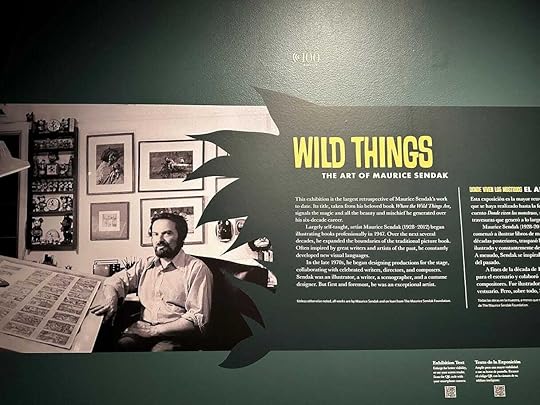 from the Sendak exhibit at the Denver Art Museum, December 2024
from the Sendak exhibit at the Denver Art Museum, December 2024Sendak died a few years later (NYT both links unlocked) and passed into the realm of the greats, the ancestors, and ancient ones. When I became an author, some years before I met Sendak, I felt (and feel still) it was such a great honor to swim in the same sea as my heroes; to make chicken soup and sing that song with Carole King; to say “When I was young in Mississippi” and write my Aurora County stories, because Cynthia Rylant wrote about when she was young in the mountains; to write about grief because Katherine Paterson had Jess and Leslie show me the way in Terabithia; to dream a dream that my moments, memories, and meaning were important and worthy of story, that even the horrors were worthy of story, and certainly food was worthy, Sendak had written a whole Nutshell book about chicken soup.
“I’m going to write about the time I met Maurice Sendak.” That’s a focus sentence. I included a first, a food, and an ancient one in this piece, because that was part of the assignment last week. Having that framework has helped me focus on one moment in time, in order to tell that story.
Who have you met on the page or in person that has enriched your writing or your life and shown you the way? Just as I wrote yesterday about bringing the ancient ones with us in the kitchen, they whisper to us and hold candles in the dark when we’re writing as well.
I’ve listed a few of my heroes above. Who are your teachers? They don’t have to be writers. You can write your comment in the style I used above. “It’s an honor to swim in the same sea as X who showed me X so I write about X.” Think on it, anyway. Think about the ancient ones especially. They are always with you; you don’t write — or do anything — alone.
In the Lab tomorrow, we’re starting our second week of writing about Firsts, Food, and Ancient Ones. There will be a tweak. I can’t wait to see what you do with it! It will be FUN. Guaranteed FUN. lol.
Join the Lab and become a Lab Coat!
Which brings me to Flannery O’Connor. It’s her birthday today. I’ll write about that tomorrow, which is when you’ll see how Miss O’Connor plays into our FUN. In the meantime, I will leave you with this delicious LitHub piece by Caroline McCoy that you don’t have to read right now, or ever, but that’s a lot of FUN and that — if you’re in the Lab — it would behoove you to have read for THE TWEAK tomorrow. The title of the piece: “Flannery O’Connor’s Two Greatest Loves Were Mayonnaise and Her Mother.”
You know you want to read THAT.
And WITH that, I leave you. Until tomorrow, Wild Things.
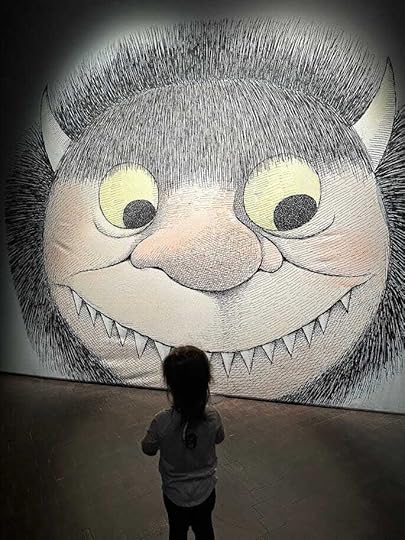 Grandgirl Evelyn meets one of Maurice Sendak’s Wild Things at the Denver Art Museum last December. What would your Wild Thing look like? :>
Grandgirl Evelyn meets one of Maurice Sendak’s Wild Things at the Denver Art Museum last December. What would your Wild Thing look like? :>xoxox Debbie
March 24, 2025
Storybelly Digest #6: The Art of Sifting
To Sift or not to Sift? That is the question this week.
Sifting, as in the dry ingredients for a cake, for a story, for a life. I’ve experienced all three siftings this past week, and that’s where I want to focus this week’s Digest.

Some housekeeping first: In order to use the photos I want to use each week, and to write about Digest topics at slightly more length than “nearing email length” allows, just know that you’ll sometimes be prompted near the bottom of posts you read in email (this seems to be true mostly for Gmail accounts and isn’t a Substack thing) to click through to the web to finish reading, if I go long. I don’t mean to go long. It’s sort of like the Sixties Trilogy books, though. People would hold them up as doorstoppers and say, “Wow, 400 pages!” and I’d say, “Yeah, but a third of those pages are scrapbook pages/photographs!” Something like that.
One more house keeping note: I’ll be working in DC area schools next week, and I’ll take you with me. I’m hoping the Digest appears in good time on Monday, the Extra on Tuesday, and the Writer’s Lab on Wed., as usual. If I bumble a bit, it’s because I’m multi-tasking, I’ll get there. I’m hoping, when I leave schools and a family event on Thursday, to travel home through Charlottesville, Virginia, for some research. I’ll take you along there, too, and will be talking about my work in progress, writing historical fiction, and research for same, in the Writer’s Lab next week. You can join in here:
But for now, and for everybody, always: SIFTING. :>
In the Writer’s Lab we’re in the middle of a two-week assignment writing about Food, First, and Ancient Ones. The CHAT is phenomenal! And, as it turns out, in something I didn’t plan in advance, all three of those elements sifted their way into my everyday life last week when a friend called and wanted to know if we might host a gathering to commemorate the one-year anniversary (a first) of a mutual friend’s passing (Comfort would say, from her Top Ten Tips for First-Rate Funeral Behavior, don’t say passing, because we’ll wonder what grade he was in; say death, it’s plain-spoken and true).
We hosted a few friends with some Cake, of course (my standard scratch cake), and companionship. We told stories about our friend who left us a year ago (an ancient one). There was an impromptu poetry reading, two good songs sung by them that brought a ukulele and a guitar, good food passed around, J brought her brother’s favorite cornbread, as it was her brother who had passed on, and we basked in one another’s good company, into the warm spring night.
As I made the cake that afternoon before the gathering, I thought about how I’d heard from two different folks recently their theory that when you enter the kitchen to cook, you bring with you all the ancestors who have cooked before you. You bring their knowledge, their memories, their particular strengths and stories, and their hard-earned wisdoms that carry you through. You are never alone.
I thought about that in relation to Story. I often say, when I’m working with writers or speaking from a podium, that I take my life and I turn it into stories. And that is true. How much of my ancestors’ lives do I bring with me?
How far back can I remember them, and remember my own story? Here is a part of my chocolate cake story, going back to the ‘90s, although I wrote all over this recipe elsewhere before it found its way into a church cookbook:

In the Lab Chat we’ve shared enough recipes to warrant a recipe tag or section for them at the top of the Storybelly home page. Look for that soon.
As to sifting, I’m always thinking about it, because it’s what we DO. Moments, Memories, Meaning… that’s what goes into every story we tell or sing or act-out or write — the Moments of our Lives, the Memories we have of those moments and the Meaning we give them. I have a friend (more than one friend, if I’m honest) who thinks that sifting is so yesterday, that we don’t need to sift anymore, that recipes don’t even call for sifting anymore, and yet she/they are wrong. Wrong, I say! Sifting is Life!
Sifting is how we order everything, how we make our choices, and what those choices look like when they come together. Like my choice on Saturday to make a cake the way my mother did, and to trace and cut out rounds from a paper bag to fit each layer of the cake. The decision to sift the dry ingredients, to use the hand-held mixer, to pull out my grandmother’s glass cake plate and cover.
And then the foraging around in what we happened to have already, the idea to use the green plates for spring, the white candles for ambience and honoring, the eucalyptus and pussy willows for the flowers. We sifted that along with friends who brought the photograph for a makeshift altar alongside the favorite whiskey, the candles, and the moments, memories, and meaning we all supplied (both collectively and individually) from the years we’ve known one another, and the years we were lucky enough to know our friend among us.
It’s all about the Sifting. The Food, the Firsts, the Ancient Ones… and, of course, the Irish Blackberry Fool (NYT unlocked):

Because, of course, there is a bit of fool in all of us, and good thing. Some think the “fool” in the recipe comes from the French “fouler” which means to crush, or press, which is what the traditional recipe calls for with the fruit, but I much prefer the idea that we’re all jesters of a kind, and fools for love and community and togetherness and stories. That’s my jam. I’m glad you are along, here at the ‘belly, for the fools’ adventure!

In the Lab, we’ll start Week 2 of our Food, Firsts, and Ancient Ones writing. (Link is to the Writer’s Lab post last week, where all can read the prep before the assignment.) I’ve already excerpted (in the Chat) part of an unsold novel that has those three elements in one passage, and I’ve written a new piece (we’re talking short passages here) of going to visit my Aunt Mitt when I was a kid, the first time I walked there on my own, and she was waiting for me with her many-days (weeks?) old yellow cake and her signature “blackberry acid” to drink (a precursor to today’s soda pop).
I want to expand, in the Storybelly Extra this week, on bringing the Ancient Ones along with us when we write, and in every endeavour. It’s like Patricia MacLachlan wrote, in my favorite picturebook of hers: “What you know first stays with you.” We’ll talk about that.

This week in American History holds the juxtaposition of two events I write about in Revolution:
The week that “She Loves You” (YouTube) by the Beatles hit #1 on the American Billboard Hot 100 (preceded by “I Want to Hold Your Hand” and followed by “Can’t Buy Me Love). Sunny and her friends can’t get enough of the Beatles. Yeah yeah yeah! 1964.
In this same week, the third attempt to cross the Edmund Pettis Bridge in Selma, Alabama, was successful. “The third march started on March 21, with protection from 1,000 military policemen and 2,000 Army troops. Thousands of people joined along the way to Montgomery, with roughly 25,000 people entering the capital on the final leg of the march, on March 25.” 1965.


I’m proud of the publishing partners who helped give birth to these books, to the teams that have helped them find readers, and I am grateful for every reader who opens these books and sees a bit of history and home, community and compassion. I hope readers connect to their own place in history and home when they read my books. You can find out more about each book, and you can buy them, too, at my website. You can also check them out at your local library, and on Libby.

This week, I would love for you contribute to the Storybelly Cake Register. lol. I don’t know what we’ll call it yet, but our ops-guru, Zach, is going to make us a section for recipes, since we’re all chatting about them already, both in comments and in the Chat. Maybe we’ll call it the Home-Ec Home. What are your favorites, when it comes to CAKE? Here is one of mine, and you have the recipe, above. Thank you to all who have commented in so many different ways to so many different threads this past week!
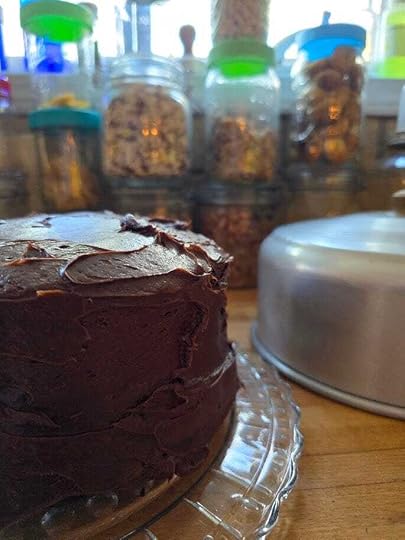
And thank you from our Ops-Guru, here shown after sifting pantry ingredients to figure out some brunch on Sunday. He is nothing if not versatile. Thank you for all you do for us, Zach. And you, too, Bobo, who is there for quality control, of course.
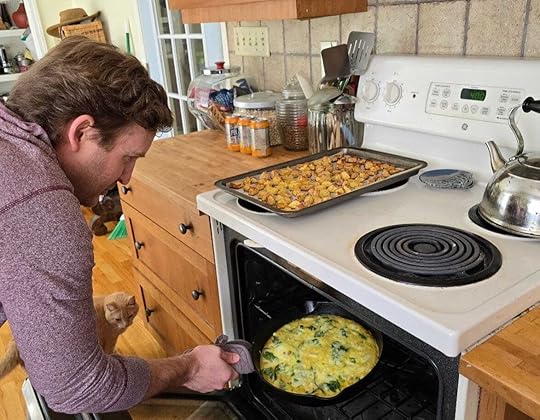
That will be a wrap for Storybelly Digest #6! I am packing and preparing to go, on the weekend. The pine pollen started falling yesterday, here in the South. There is a coat of yellow on everything. Welcome, Spring!
March 19, 2025
Writer's Lab: Food, Ancestors, and Storytelling Magic
Welcome to all the new folks in the Storybelly Writer’s Lab this week! Subscribing members: be sure to visit the Introductions and introduce yourself to the Lab (aka Lab Coat) community and see who else is here. Lab Subscribers get access the Lab Chat where we share our writing and support each other, as well as all previous and future Writer’s Lab lessons and assignments. Questions? Drop them in the comments and they will be answered promptly by me or by our Lab Coat Ops Guru, Zach.
Two additional notes this week:
We’re getting into longer-posts territory with Lab Posts starting this week. If the newsletter gets truncated on your phone or on email, you can click through at the bottom (where you’ll find a message to do just that) to come to the web and finish reading it — photos will be bigger and better on the web anyway, and if you’re a claustrophobe, like I am, you’ll audibly sigh to have so much more room.
We have been getting to know one another and doing introductory exercises this first month in the Lab. We’ll be moving toward more integrated assignments soon. Watch for a post in early April that sets us up on a quarter system for writing about our lives in ways that give us lots to think about and explore. Today, in a looser exploration (the way all Lab posts have been so far), let’s play with first chapters.
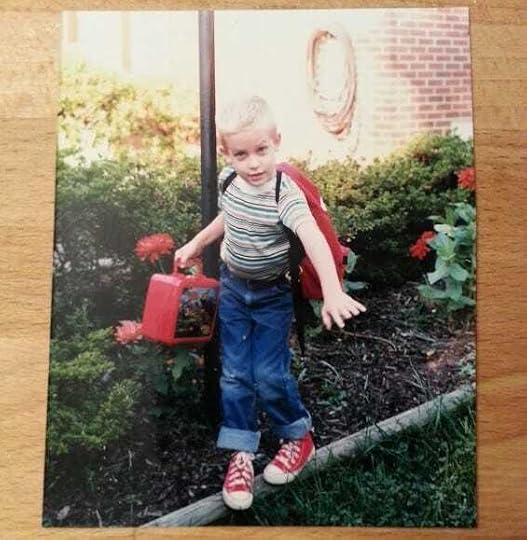 Ops Guru Zach on his first day of first grade.
Ops Guru Zach on his first day of first grade.In this assignment, we’re going to explore Firsts, Food, and Ancient Ones. All in one chapter, paragraph, poem, essay, list, or vignette; Writer’s Choice as to what form the assignment takes. I’m going to show up in the Chat every day to see how you’re doing, and to assess what might need massaging as we go through the week. I am also doing the assignment (ulp!), so look for my work in the Chat as well.
Also, in anticipation of the syllabus for an official Lab Quarter coming up on April 2, let’s say that this first chapter (paragraph, etc) will be something we work on for the next two weeks. I’ll write more about this in next week’s Writer’s Lab, and we can share snippets of what we’re coming up with in the Chat as well. Experiment! That’s what the Lab is for. Pull out yer Erlenmeyer flask and get ready to fill, mix, heat, cool, incubate, filter, store, and share. Ahem.
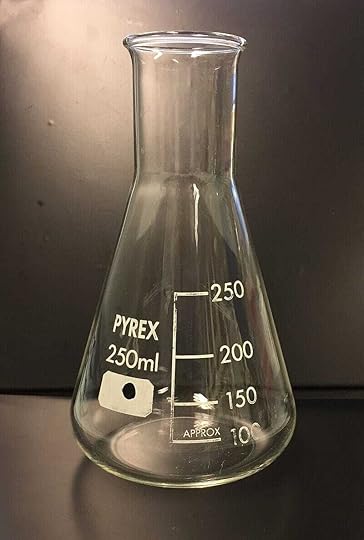
Some food for thought:
Look at that first grader (way) above. CUTE! Ready! Prepared with new red lunchbox, new red sneakers, new, confident stance (balancing on that beam), new haircut, new everything, to meet his new first day in a new grade with a new… you get the idea. I want you to think of a FIRST.
What ARE Firsts, exactly? They can be fluid — not necessarily a thing, or event, maybe more a realization, or maybe something in general that’s happening, like the idea of First Grade for the First Grader above.
So far we’ve talked about first lines (here, if you missed it), and authentic narrative voice (at the same link), focus sentences (and finding focus), massaging memory in writing stories, and writing canons, among other topics, including the power of listening and how writing about food can present so many opportunities to tell stories.
None of those things really appears much in We Like Kindergarten, written by Clara Cassidy, art by Eloise Wilkin, a book about “the time that” Carol went off to kindergarten, but I present it as a way to look at very simple storytelling (I was going to say “bland” but I know this is a Little Golden Book from 1965 which was an entirely different time-and-place and it was meant for the very young, in the most straightforward way, and I can appreciate it for what it is and I love Golden Books).
I read We Like Kindergarten almost as a calming device (hahahaha) to the cute kid above before he started kindergarten, a year before that photo was taken, a time when he stood at the end of our driveway, with some trepidation, to wait for the big yellow bus that would whisk him off into another world. Now he spends part of his days trying to keep his cool when the Storybelly content creator misses her deadlines, but I digress. (I mean… here we are, on the appointed day, a Wednesday, it may be close of business, but we’re here! Love you! Mwah!")
What I want you to do, Lab Coats, is to consider this Little Golden Book that’s about a first. Here’s the lead, the opening line:
My name is Carol. I am going to kindergarten. I go to kindergarten every day.
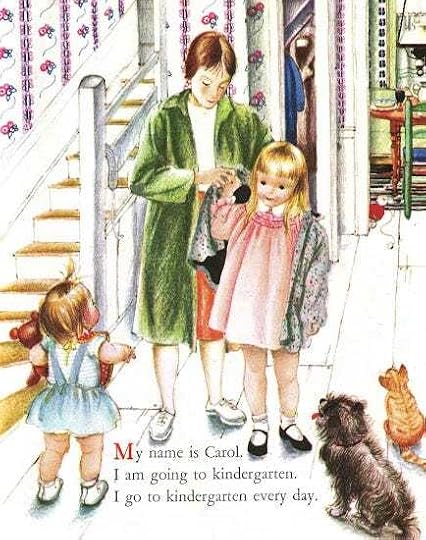
You can listen to this book at YouTube and follow the page turns here.
What to notice, when you read this book:
Notice the FIRST and how it is presented throughout.
Notice the CIRCLE in the way the book is written. (beginning/middle/end)
Notice the way DETAIL is handled, a declarative sentence followed by examples, over and over, through the book (see? calming device…)
Notice the use of REPETITION, full sentence repetition. (also comforting)
Notice in the ART that Eloise Wilkin has painted a racially integrated classroom at a time (1965) when many schools were not integrated. (We could dedicate an entire Lab Post to this and other details about We Like Kindergarten, I know, but let’s stick to the assignment for now.)
Then, compare We Like Kindergarten to another picturebook (1991) about “the time that,” with a very different lead or opening line:
I will always remember when the stars fell down around me and lifted me up above the George Washington bridge.

This is the first page of Tar Beach by Faith Ringgold. (The link is to Faith reading her book, on YouTube. Rest in peace and power, Faith Ringgold. We are lucky to have known you, and what a legacy you leave.)
What I want you to notice here, when you read Tar Beach, is everything about We Like Kindergarten, you might make a list of things you notice, plus, for our purposes:
Notice the FIRST and how it is presented throughout the story. (same #1 as WLK, but a totally different list, right?)
Notice the FOOD and how it is folded into the story. How does it help tell the story?
Notice the ANCIENT ONES and their place in the story. How do they enrich the story?
What else do you notice?
And now, to THE ASSIGNMENT:
March 18, 2025
Storybelly Extra: Food, Glorious Food!
I am not a food writer, but I write a lot about food. I am not a foodie, but I scour recipe websites for the food projects I’ve set myself up to conquer (ha) — biscotti, chiffon cake, popovers, caramel, eggnog, pimento cheese, mayo, sauerkraut, meatballs that don’t taste like cardboard rocks. The list goes on.
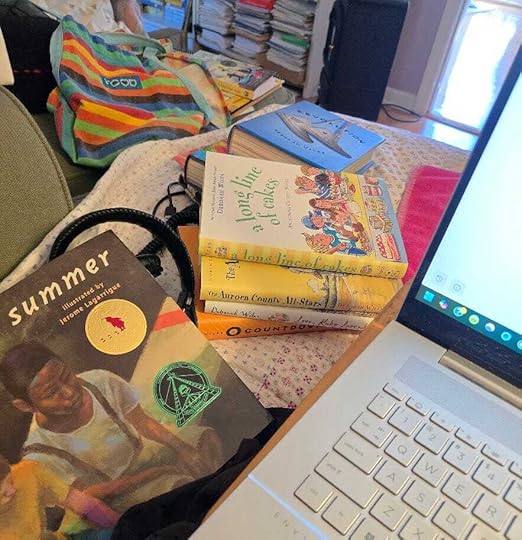 I surrounded myself with my books so I could pick out passages with food in them, quickly realized there were just too many, and this newsletter is already long enough. I took off my thrifted apron… it says “food” on it… ha.
I surrounded myself with my books so I could pick out passages with food in them, quickly realized there were just too many, and this newsletter is already long enough. I took off my thrifted apron… it says “food” on it… ha.Weekly, I’m making something food-related, often something new. I missed St. Patrick’s Day completely yesterday, as my day was over-packed with Other Things, including one more birthday; so overpacked (does that word have a hyphen?) that, when I stole a couple of hours from it to “do nothing” and reset (re-set?) I crawled in bed and read a book, which restored me, then I slept the sleep of the dead but not really dead, so today I hope to make the Irish Blackberry Fool (NYT unlocked) that I have all the ingredients for and was so looking forward to yesterday.
I don’t cook to be restored, or for a break. Cooking requires my attention. Richard Osman does not. He understands that he is there to entertain me, with murder and humor and — now that I think about it, having finished We Solve Murders with minutes to spare before Libby reclaimed it — not much food. Hmmm.
This morning, after I finished making my coffee and while the boiled eggs for the week were steaming, I put a whole chicken in the crockpot then floured and sauteed some stew beef from the farmer’s market (YDFM in Decatur) for a beef stew we’ll eat later today. I’ll pick the chicken from the bones and make bone broth, much later today, and we’ll have chicken for many recipes this week.
I took photos of my work, hahahaha.
I am not a photographer, but I photograph a lot of food. And ingredients. And my flour canister. And my mother’s rolling pin. It’s history! Food “situations” loom large in my life. lol. Omg, I did just write that, so come with me, let’s talk about what we write about when we write about food. It’s not murder.
Read any of my books (and many blog and social media posts) and you will encounter food.
Why? Because it is so handy to this writer, and to so many of us. Food is a writer’s tool. It evokes strong emotion from both the writer and the reader. Here are six things that food does for a story. There are more:
Food creates your characters. What do your characters eat? What do they say about what they eat? In Each Little Bird That Sings, Comfort and her Great-great Aunt Florentine live with their family on the floor above their funeral home. You can imagine all the funeral food that comes into that big rambling house and enormous kitchen. Comfort and Aunt Florentine are writing “Fantastic and Fun Funeral Food for Family and Friends.” Really! My brownie recipe is in the book. So is Mrs. Elling’s Chicken and Potato Chip Casserole, and my mother’s sweet iced tea recipe. Each recipe is set-aside on its own page. What kind of characters sit at the window with binoculars to watch people arriving for funerals, and judge their food after, putting only the best into their cookbook?
Food enhances setting. In Freedom Summer, “Annie Mae makes dinner for my family every night. She creams the corn and rolls the biscuits.” And later, “Mama helps my plate with peas.” “Daddy stirs his iced tea…” You know you’re in the South, from the food, the word choices, and the characters. You know that Annie Mae is the cook, and the illustrations show you that Annie Mae is a black domestic worker. You see the white family at dinner in the dining room, and you also see, unwritten but shown in the art, and implied in the text, how Annie Mae and her son eat in the kitchen.
Food pushes the plot forward. In every book I’ve written, I’ve incorporated a meal, at least one gathering with food, where my characters can talk to one another, secrets can be revealed, arguments started or resolved, mysteries hinted at, problems solved, wisdom passed on, decisions made, and the story moves forward. Having a big meal together is almost like a shorthand, or shortcut (short-cut?) to eliminating many tedious scenes delivering information piecemeal.
Food celebrates cultures. In a book I’ve written but have not sold — This is Cambria Bold! — I explore different cultures through the lens of blended families, ancestral homes and ancestors, and the food of their people. I so love this book. We will find a home for it. In the meantime, there is the competition to prepare for, the National Not-Quite 4H-Club County Fair Crisp Cooking Competition. You can imagine, maybe, all the ways that apples appear in many cultures.
Food brings communities and families together… for better or worse! Some of the liveliest scenes in my books take place at a dinner, a picnic, a restaurant, breakfast, a birthday, a funeral, making root beer floats, where the food seems incidental, but it’s the reason people are gathering. It’s harder to authentically have people decide to meet en masse somewhere and talk things out, but if they find themselves together for an event where there is food, even if it’s “just” the breakfast table, well then! Anything you need to happen, can happen here, while you’ve got everyone together. Or maybe someone important is missing? Why? What happened? In Each Little Bird That Sings, think of Comfort’s dog, Dismay, missing, while Comfort and her family have ice cream sundaes for breakfast — a “hero’s breakfast,” says Aunt Goldie, her idea for the rescuers, that she serves on the front porch. A distraught Comfort — “where is my dog?” — tries to eat, but loses her breakfast… over the railing it goes. She is enveloped by her family, in her grief. It was food that brought them together to that moment.
Food allows you to remember your own childhood (for better or worse, too). Remember, you are mining your life in service of story. Franny talks about the canned biscuits that her mother removes from the oven a minute before they are done so she can insert one quarter of a slice of American cheese inside each one before returning the pan to the oven, in Countdown. I watched my mother do this dozens of times when I was a child.
In Revolution, a full-on, lively Sunday dinner with fried chicken, mashed potatoes and gravy, sliced tomatoes from Uncle Vivian’s garden, butterbeans and buttered biscuits is being consumed as an argument erupts over the preacher’s sermon about opening the doors of this 1964-Greenwood, Mississippi Presbyterian church to “everybody under the sun, no matter what color.”
I tapped into my own history as I wrote this story, and brought my characters together through food in this scene, food that’s doing all six of the above things food can do for you, at once. Food is an incredibly versatile tool.
I took a break while writing this essay to check on my chicken in the crock pot, and to add carrots and potatoes to the simmering beef in the stew pot. I see that my ops-guru, Zach, has started farro in the rice cooker. I see knobs of garlic on the counter, and scattered bay leaves, from his efforts. The plot thickens, as does the stew. Jim will appear at some point and make one of his signature salads, I will cut the birthday-party leftover corn off the cob and cream it. We will have a meal. End of that story, beginning of another.
Cooking for my people is my love language. Cooking for others creates stories — and recipes — that people will pass down for generations, in the way that my mother passed down her mother’s directions on how to cook a turkey, which I highlight in a Storybelly post about narrative voice (scroll down on that post for a photo of Mom’s handwritten recipe). Mom was a journeyman/woman cook, a woman who came of age cooking after World War II, when Birds Eye and Chef Boyardee and Pillsbury’s canned biscuits were coming of age in 1950s kitchens. I highlight Mom’s pink kitchen in Countdown, when Franny tells us, as a list, which meal each night of the week entailed, every week. That was my Mom’s way: Functional. Practical. Efficient. Simple. Precise. You see how food describes us?
Just about anything you write can be enhanced by food, whether or not you like to cook, or cook at all. I am preaching to myself here, because my current work in progress, Charlottesville, has precious little food in it right now. Must remedy that, if possible.
This is a post for everyone, as all Storybelly Extra posts are. Tomorrow, in the Writer’s Lab, we will take this idea of food (and first chapters, as I wrote in yesterday’s Digest) a step further. I think we’ll add in some ancestors. It’s a recipe! A recipe for a Lab Coat assignment, one that I will do with you, and that we do for fun and for whatever else suits us.
You can join us in the Lab, here — all are welcome.
And if you want to exercise your chops in advance, put me a food memory in the comments. I will start, as soon as I pull the chicken from the crock pot off the bone. Let’s make it a one-minute write, for all subscribers. Whatever you can write for a minute — you can time yourself — so it’s a freewrite for one minute, okay, maybe two. Whatever comes to mind. There are no mistakes. Include ancestors if you like, or a first time, a last time, something food-adjacent. It’s your story. Go!
xo Debbie
March 17, 2025
Storybelly Digest #5
Good morning! To those who have been here an entire month (wow!) and to those just joining us, I see you! Thank you for hanging out here with me/us.

It feels good to check in with you every Monday morning, to see how’s-by-you? — as an ancient old friend used to say when she’d call me — on a rotary phone, no less, with a party line — who remembers party lines? My grandmother, the real Miss Eula, was famous in real life (and maybe she was in Love, Ruby Lavender as well), for her skill in picking up the phone where no one on the line could notice, when the ring-ring! on the incoming phone call was definitely not “her” specific ring, but she’d pick up the receiver anyway, quiet as could be, barely breathing, so she could listen in on the town gossip.
These days I’m moving toward ancient friend status, more every day, but I still might have another 30 (ha!) years on this knob, if I listen to Lloyd Kahn tell it. Here’s the link to his Substack, “Live From California.” Lloyd was the shelter editor for the Whole Earth Catalog in the Sixties, is 89 years old, turning 90 in a few weeks, and thinks he has another ten years in which to write the next book, to go back to Burning Man, to swim daily, to have fun, and to search for adventure.
I’ve just finished reading Lloyd’s occasional email newsletter, Gimme Shelter. That link is to Feb. 2024’s newsletter at Gimme Shelter and will give you good background, but the March 2025 newsletter I just read isn’t posted yet — if you’d like to read it, let me know and I will forward it to you. It includes his adventures at Burning Man in 2024! And many other fine insights, including his book The Half-Acre Homestead, which I’ve used for inspiration, here on my little half-acre, for years.
Another 30 years would make me 101. I’ll take it. Really. As someone who was afraid of dying all her young life, and wrote an entire book about it — no, more than that — who started three different novels with death (Ruby, Little Bird, and All-Stars), I’ve been figuring out death all my life, it seems. Trying to make friends with it.
And not just death in the physical sense, but the losses that feel like death, and are a death of another kind. The loss of home, of family, of youth, of opportunity, of health or hardiness, of friends, of time, of all the things we must let go of as we age and, one hopes, mature in understanding.
I have long held on to a guidepost poem for me by C.P. Cavafy titled “Growing in Spirit” although I always think it is titled “Half the House.”
He who hopes to grow in spirit
will have to transcend obedience and respect.
He will hold to some laws
but he will mostly violate
both law and custom, and go beyond
the established, inadequate norm.
Sensual pleasures will have much to teach him.
He will not be afraid of the destructive act:
half the house will have to come down.
This way he will grow virtuously into wisdom.
Working on it, Cavafy. Working on it.

I’m reading Richard Osman’s newest novel, We Solve Murders, which is full of completely fictional characters, and completely unbelievable situations, but who cares. The romp is funny and light and just what I need, she who wants to write a cozy mystery one day. Let’s write one together.
Libby tells me We Solve Murders is due back to my library in 7 hours and I am 56% through it. I have already put a hold on it so I can finish it the next time it appears in my inbox, although I am number 46 on the wait list. I will happily read/listen to other books while waiting. “Murderers! You can’t have ‘em all!” is the first line of Love, Ruby Lavender, who is familiar with murder. :>
We are watching Boardwalk Empire, our second-time through, but it’s been many years since we saw it last. The mafia story is secondary (or less) to me. In the mood I’m in, I find myself thinking about the writing, and how time and place is represented, and the passing of all these characters from 1920s Prohibition into history.
I felt the same way about Deadwood, although the plotting and the dialogue were so rich, I was swept into those episodes like I had ancient old friends there: Wild Bill, Calamity Jane, Al and Doc and Bullock (insane, truly) and Sol and Charlie Utter and Ellsworth, real historical people, now all gone.
It’s not a maudlin thought, not really, as there are such gifts along the way to becoming an ancient one, such signs that we do go on, in some way. I took these in a walkabout in my yard last week, as the dead of winter gave way to spring:
I want to say something clever here about awakening our writing with the coming of spring, but I feel thick this morning, after a welcome weekend full of family and good food (the two go hand-in-hand, yes?) and so much celebrating — spring, birthdays, seeds, good coffee, deep conversations, calendar-making decisions, and a realization that we may be past any more freezing temperatures this year, which means that maybe my nectarine trees (and pears and blueberries and more) will bear fruit this year. What are you watching, listening to, and reading right now? Give me some suggestions…

This week, look for an extra on what we write about when we write about food, using the Aurora County books and the Sixties Trilogy for examples and reasons and ways you can take this writing idea into your classrooms with your students, or into your own writing and storytelling. I’ll focus on Each Little Bird that Sings and Comfort’s “Fantastic and Fun Funeral Food for Family and Friends,” lol, since this is Little Bird’s 20th anniversary. I will save some thoughts on “what we write about when we write about the ancient ones” for a summertime day. Little Bird also begins in spring, and ends at Thanksgiving… so there’s a time-and-place story-arc to consider as well.
If you are subbed to the Storybelly Lab (we somehow have started calling ourselves Lab Coats, even as I (like Miss Eula) prefer to wear a duster), we’re going to talk about first chapters. They can involve food, or not, ancient ones (like Little Bird begins) or not, but we’ll use a first chapter of Lloyd’s to look at how we approach personal narrative, time and place, and ways of showing and telling. I’ve linked to Lloyd’s chapter at his blog, here, so you can get a jump on Wednesday’s Writer’s Lab post that will set us up for some writing of our own over the weekend and into next week. Assignment/Exercise to come, in the Lab. We can share what we write in the Chat as well, open to all Lab Coats as a community space in which to share stories, triumphs, struggles, questions that relate to our writing (and many recipes for CAKE so far, lol).

This week in history and Deborah Wiles books, I’m sticking with thinking about the ancient ones and food and time and place. Let’s do that this week. Make your three columns, everyone is welcome, this week let’s call them: 1. ancient ones; 2. food; 3. time and place (time and place as in history, yours or not yours). What stands out to you as you make those lists? Write about that. Share it with us in the comments below. I will, too.


I’m proud of the publishing partners who helped give birth to these books, to the teams that have helped them find readers, and I am grateful for every reader who opens these books and sees a bit of history and home, community and compassion. I hope readers connect to their own place in history and home when they read my books. You can find out more about each book, and you can buy them, too, at my website.

I’ll leave you with a video of Lloyd Kahn in his kitchen, doing the dishes. This, as you can imagine I’m going to say, is a story, my friends. Would you write about how you do the dishes, with details (order of operations)? With reminiscences of how your ancient ones did the dishes? My Aunt Evelyn, for example, used to tell me to run-on, don’t worry about standing there with my drying cloth at the ready, go play, because, she said, “Honey, I let God dry the dishes.” I was ten years old when she told me that, on a Mississippi summer day; I still remember it.
Here’s Lloyd extolling the virtues of baking soda in washing the dishes:
Let’s use that as a writing prompt this week. How do you wash the dishes??? Literally, figuratively, magically, write it or don’t, as I always say. :>
And that’s Storybelly Digest #5. A new month for Storybelly, a new season for all of us, a spring equinox ahead that means a full season to bask in, toil in, survive or thrive in (usually a mixture of both), and a week ahead that’s got possibility (and food, and first chapters, and personal narrative) written all over it. Have a good one.
xoxoxo Debbie
March 12, 2025
Writer's Lab: One Month In
Good morning, Lab Coats — and Everyone! It’s Wednesday. The Storybelly Writer’s Lab is one month old! And so is Storybelly. We’re celebrating over here that Storybelly is One Month Young and we are still standing, have had a great and terrible time navigating the thrilling seat-of-our-pants days that have given us already so much to archive, to talk about, to write about, to laugh over, to get all teary over… what a lovely and chaotic ride.
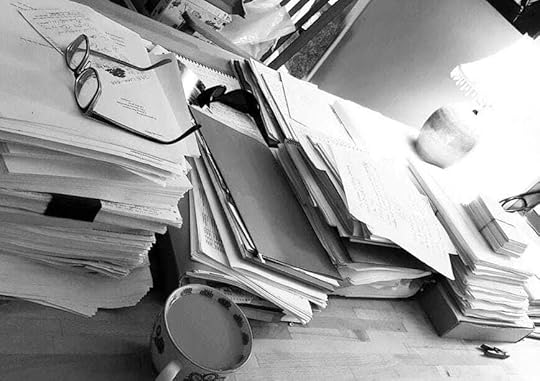 My manuscript pile, taken from the bottom shelf of a bookcase in my office. Whew. Lots of work in here, much of it unsold. But I keep at it. I am constantly learning, honing my craft, stumbling through, finding new ways of showing and telling, new characters who grab me by the heart to tell me their stories, learning a lot about myself, and others, and the world, as I do. It’s good work. I’m lucky to have it. I’m lucky to get to do it with you.
My manuscript pile, taken from the bottom shelf of a bookcase in my office. Whew. Lots of work in here, much of it unsold. But I keep at it. I am constantly learning, honing my craft, stumbling through, finding new ways of showing and telling, new characters who grab me by the heart to tell me their stories, learning a lot about myself, and others, and the world, as I do. It’s good work. I’m lucky to have it. I’m lucky to get to do it with you.Things will calm down soon. She prayed. lol. Thank you to all who have subbed, AND to those who have tiptoed into the Lab to write — this is going to be fun. It already is! See below. As they say.
We’ve had four Lab posts so far, on these topics:
What is your Canon? Massaging Memory to Find Your Story
Revenge of the Focus Sentence: Navigating Unexpected Change
Unlocking Your Authentic Narrative Voice: Give Yourself Permission to be Authentic
Exercise #16: What We Write About When We Write About Our Lives
We’ve shared favorite books that have changed us or have revealed us to ourselves, or books that have formed our perspectives in life (pick two books you love, at random, without thinking too hard about it, and tell us why they resonate for you);
we’ve introduced some writing concepts that we’ll explore as we go forward, particularly the ideas of “one clear moment in time,” focus sentences”, and “moments, memories, meaning;”
we’ve looked at ways to navigate getting stuck (I highlighted my experience with my current work in progress, Charlottesville);
and we’ve talked about first lines and their importance, putting many of them in the Chat and telling fellow Lab Coats why they “stick” with us.
That last would have qualified as my favorite of the month, except that… we’ve had CAKE! In the Chat we’ve had stories and recipes about cake: the Spicy Ginger Applesauce Cake (with cream cheese icing!) that was my downfall (in pounds gained, and no regrets) two weeks ago; Jennifer’s mom’s Oatmeal Cake (complete with handwritten recipe cards); full treatises (treati?) on German Chocolate Cake (recipes to come) and how D likes the cake alone but I must have the Coconut Butter Pecan Frosting.
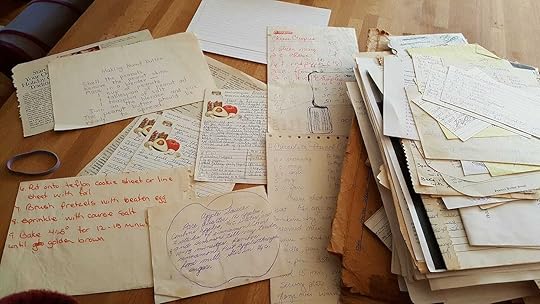 An attempt to organize the bazillion recipe cards and stacks I’ve accumulated over, gosh, 50 years? More years than that. The applesauce recipe is from my elder son’s kindergarten days (mimeographed!)… same with the pretzels on the far left in orange, from my eldest child’s school days… maybe even day care days. What stories are in here, eh? I know you have them, too.
An attempt to organize the bazillion recipe cards and stacks I’ve accumulated over, gosh, 50 years? More years than that. The applesauce recipe is from my elder son’s kindergarten days (mimeographed!)… same with the pretzels on the far left in orange, from my eldest child’s school days… maybe even day care days. What stories are in here, eh? I know you have them, too.We are just getting started. We think we must create a recipe section, here at Storybelly. I concur. Stand by.
What’s ahead in the Lab? Well, this month was an introductory month of general thinking-about-story, with one “official” assignment, Exercise #16. Assignments are always optional to do… I find that just THINKING about an assignment, and using my notebook to scratch out ideas during the week (weeks) leads me to a story idea.
And so much of what we talked about in this first month was in service of generating ideas… did it seem that way to you? These posts were meant to prime the pump for what’s next. In those early posts, you can see a path ahead, if you look closely.
It’s all a set-up for things to come. :>
Notebooks are next. One Clear Moment in Time is Next. Character Studies, Writing Dialogue, Describing Setting, Plotting (the hardest thing for me), Creating Tension, and When to Use Initial Caps. ha. And more.
I’ve got a syllabus for us as well, which I’ll roll out soon, and it doesn’t matter if you are writing for publication or writing for your grandkids and planning to leave your book in a trunk to be found by them into the long future. Or maybe you are writing for your own good self. I do a lot of that. It helps me, in so many untold ways.
Let’s write together. What I’d like you to do this week is write to me. Write to me in the comments on this post, which I’m going to leave open for all, or write to me in the Chat, or DM me here at Substack. Write me whether you are a Lab Coat, a Storybelly free subscriber, or even if you are visiting today.
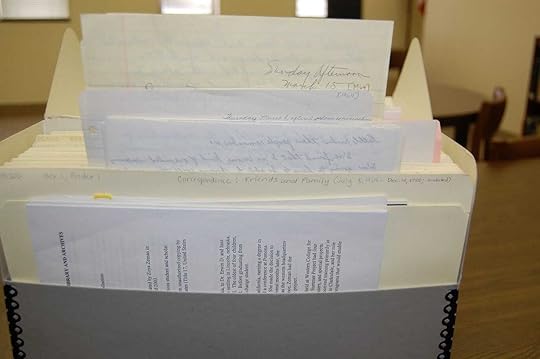 These are letters from the Kent State May 4 Archive at Kent State University. They were part of my research for writing Kent State. “Just” letters. Letters that have left an important legacy of a time and place and of American History, and how these letter writers experienced it. Letters from townspeople, teachers, students, parents, and so many more… all experiencing this moment in time differently, every story important.
These are letters from the Kent State May 4 Archive at Kent State University. They were part of my research for writing Kent State. “Just” letters. Letters that have left an important legacy of a time and place and of American History, and how these letter writers experienced it. Letters from townspeople, teachers, students, parents, and so many more… all experiencing this moment in time differently, every story important.Write me and tell me how this last month in the Lab has been for you, if you are a Lab Coat, and tell me what you’d like to see going forward. What would be most helpful to all of you? What are your writing challenges? What are your strengths?
The Digest will continue to be an archival, legacy, and fun project for everyone, and it will also offer up writing ideas for you. In the Lab, we have a chance to be the change we want to see in the world. To dig down deep and work on specifics, to shape our stories, and along the way to help ourselves be the best and most heartfelt writers we can be. To make our dreams a reality.
I know I’ve said it before and I’m sure I’ll say it again — we *are* stories. Every moment we live is part of our story. If we don’t find ways to share our stories — for ourselves, in community, with someone else close to us… to dance them, sing them, draw them, tell them, write them, whatever our art form, in whatever we are building and creating — they are lost to time, and so are we.
I created Storybelly in part to be a legacy project for my work. I offer it up to you in the same way, in hopes that you will find ways (and you probably are already) to create that same legacy in your own lives. If you want to. You don’t have to, of course. But I stand by my oft-said belief that we are all stories, that all history is biography, that every human being is worthy of dignity and respect, and that each person’s story is an important and essential part of the whole of our human experience.
In Each Little Bird That Sings, the sign in front of Snowberger’s Funeral Home reads: We Live To Serve. I believe that, too. I sound like a preacher here, when all I mean to say is, it’s a real privilege to spend time with you. I appreciate it. One month well-spent, and many more to go. Thanks so much.
xoxoxox Debbie
March 11, 2025
Storybelly Extra: The Power of Listening - A Writer’s Essential Skill
A thick stand of rose-of-sharon bushes had grown forever at the base of the rock. They guarded the path to the top with strong, woody branches full of wide, pink blooms. Hummingbirds and butterflies spent their days nosing around in rose-of-sharon’s sweet scent. I gave an appreciate sniff as I walked past the sentries and entered the world of Listening Rock.
— excerpt from Each Little Bird That Sings
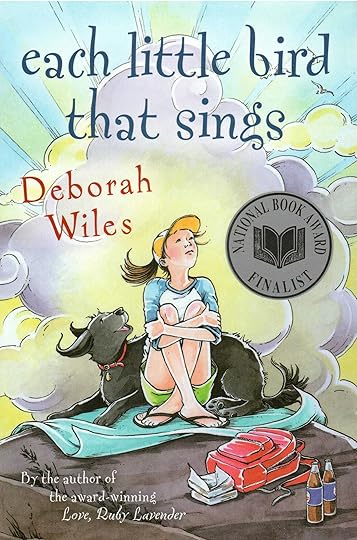
Welcome to the most exciting topic imaginable: Listening. hahahaha. Okay, so not exciting, but essential. To listen half as much as we talk or MORE than we talk, is a superpower, a peace-maker, and a boon to ourselves and to the world.
I want to learn how to listen more and better, so I write quite a bit about listening, and when I teach writing, we listen… a lot. Here is more Listening, from the same chapter of Each Little Bird That Sings:
I had to watch my footing, but mostly the walk to the top was an easy one, even in my black flip flops, and I often imagined myself as Merriweather Lewis on the Lewis and Clark expedition (Discovering Our World Magazine, Issue 14) hiking up an enormous boulder worn smooth by what Uncle Edisto said was thousands of years of water flowing over and around Listening Rock in the ice ages. “Granite and slate,” he said, each time we visited, '“maybe a little soapstone, sprinkled with limestone and quartz. Minerals galore! It’s a smorgasbord of metamorphic marvels!
Does it seem like Listening to you? It is, my friend, it is. One more example, from the same page, same book:
It was. Listening Rock glittered where the quartz sparkled it. It pebbled and flaked in the limestone places. An occasional scrub pine jutted , its trunk twisting itself sideways and then straight up, reaching for the sky. Sometimes a surprise patch of daisies grew out of a sandy place with a few determined bumblebees buzzing around them, but mostly there was wide warm rock to walk on at a slow but steady rise.
I submit these passages are heard. They engage the senses in seeing, hearing, touching, tasting, and smelling Comfort’s walk to the top of Listening Rock. You are listening to her tell you all about it. You would not have the same experience were you the person making this walk. You would notice different things, have a different context in which to categorize what you notice, or maybe you would be oblivious to the sights and sounds and smells… even to the gnats that might bat at your face, or how long the trip to the top was. Here’s how Comfort describes it:
It took about the time it takes to eat a tuna fish sandwich to get to the top. There, the surface was about the size of Snowberger’s big front parking lot, only, unlike the Snowberger’s lot, the top of Listening Rock gently rolled and sloped. The gnats that were fierce down in the oak grove were gone at the top of Listening Rock; the breeze kept them away from our faces.
Now you can hear those gnats buzzing, can’t you? You can feel the breeze against your face, you can hear the soft sound it makes through the scrub pines. I’ve primed you for it.
But you have to listen. I engage all your senses, and then I give you a payoff, after Comfort describes her dog, Dismay, at the top of the rock, and then lays out her picnic for you (more listening involved, through using the other senses). The payoff:
Everything was ready. I lay on my back on the picnic blanket, closed my eyes, pulled my Snowberger’s baseball cap down over my face, and listened to the sound of Listening Rock baking in the sun. I wondered if Great-great Aunt Florentine could hear the blue jay I heard calling right now. Maybe she could. But she would never feel this warm sunshine on her face again. Tears gathered in the corner of my eye and I mopped at them with my fingers.
Sigh. Sniff. I heard all that. I know this girl now, do you? She has suffered a loss, she has walked to the top of her favorite place, she has brought her beloved dog and a picnic, and she is awash in feeling. I am, too, reading this. I heard about Comfort’s adventure. She told me all about it. And she used all her senses to do it? What did it look like, sound like, feel like, taste like, smell like?
How do we capture listening in the stories we write? And why is it so important? When I workshop with writers, I have them make their lists with me, circle what calls to them in that moment, fashion that circled thing into “one clear moment in time,” and “the time that,” and then I have them write their focus sentence at the top of a fresh page, and I have them write short. SHORT. One page for one clear moment in time, nothing before that moment, and nothing after that moment, just “the time that.” Just to get it down. They can expand it later. Make it known, that moment.
And the way I have them do it, is through listening. Listening to one another, through oral drafting and oral revision. Eventually we will workshop, live, here at the ‘belly, and we will practice this way of working with story. It is an elegant and effective writing tool. Before you write a word, you are telling me what the story is about. Telling your workshop partner. And you are listening. You listen to your partner tell you about “the time that” and “what happened first” and the rest of the story, and then, you hear yourself do the same thing.
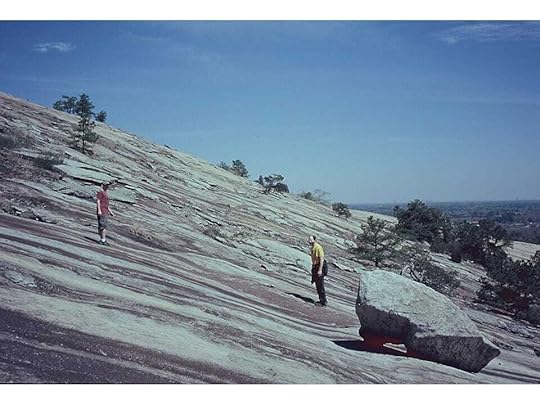 Zach and Jim walking on Stone Mountain, here in Georgia. I have walked this mountain so often, in all seasons, and to write Little Bird, I listened to it tell me its secrets — what did it look like, sound like, smell like, feel like, taste like? — then I gave those secrets to Comfort in Little Bird.
Zach and Jim walking on Stone Mountain, here in Georgia. I have walked this mountain so often, in all seasons, and to write Little Bird, I listened to it tell me its secrets — what did it look like, sound like, smell like, feel like, taste like? — then I gave those secrets to Comfort in Little Bird. Later, in revision, you can give me all the descriptive details you want, but for now, for getting at your story, you listen. Listen to what’s really on your heart, what it’s pulling at you to say, because you haven’t written it yet, you haven’t futzed with it, you haven’t judged it, you are just eager to tell someone else, and to have them listen. Listen to this! And then you reciprocate and listen to them.
It’s so simple. So elemental. And so powerful a technique. It’s also so very human.
In a scenario like the excerpts from Each Little Bird That Sings, we don’t know Comfort’s politics, and they don’t matter. We see her as human and humbled in this moment. Like us. She is small and vulnerable and open to the world, in this scene. She will show you other sides of herself, as the story unfolds. You will hear her tell you her opinion on just about everything under her sun. She will struggle and she will be lost, and she will be found again. Along the way, as you listen to her story, she will make you laugh, and cry, and recognize yourself in these pages.
This is how we change the world. It’s hard to hate someone when you know their story, when it resonates with your own, down where it counts. This is also a lesson that Comfort learns in the end, when she has lost what is most dear to her. She has found something even more important.
So I want to become a better listener. It sounds so Pollyanna, doesn’t it? But it’s not. I have to believe it’s not. I have seen the difference it makes to tell your story. To have someone listen to it. To be understood. To find something even more important than the thing we have lost.
Here’s to listening as much as we speak.
xoxo Debbie



